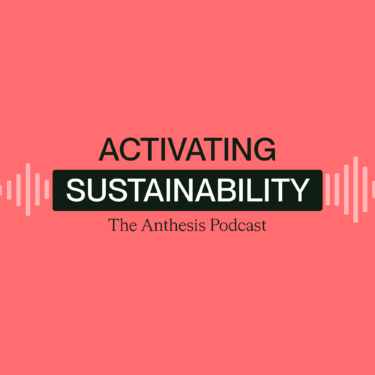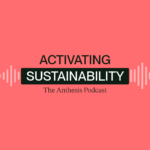
Speakers
Chris Peterson, Director
Hope Bristow
Jason Pearson
Share this episode
In this JUST IN episode of our Activating Sustainability series, our host Chris Peterson is joined by Hope Bristow and Jason Pearson to discuss the themes, emerging topics, and actions from GreenBiz24 which took place February 12-14th in Pheonix Arizona, USA.

Read the transcript
Chris: Hello and welcome to Activating Sustainability, the Anthesis podcast. I’m your host, Chris Peterson, director at Anthesis Group. Today we’re doing a ‘JUST IN’ podcast to hear about the themes, emerging topics and actions coming out of the GreenBiz conference. Joining us are two of the Anthesians who are at the event, Hope Bristow, principal consultant and forest positive lead, and Jason Pearson, executive director in the global advisory business, us. Welcome to the podcast. Thanks for joining us.
Hope: Thanks for having me.
Jason: Thanks, Chris.
Chris: So, GreenBiz is always such a valuable pulse check on the key themes, emerging topics, and sentiment in the sustainability space. To start, I’d love to hear a theme or themes that really stood out to each of you from the sessions and the chatter at the event.
Hope: Yeah, so I can begin here. I would say one of the biggest themes coming out of GreenBiz this year was nature. There were probably just as many nature-related breakout sessions and workshops as there were sessions on things like ESG regulations, climate targets, et cetera. There seemed to really be a shift this year in the types of discussions that were happening in that more attention is being paid to nature and the fact that we can’t reach net zero without solving the nature and biodiversity crisis. So I heard a lot of discussion around the fact that climate and nature are really working hand in hand. In order to align with a 1.5 degree future, we need to not only significantly cut emissions, but also restore and preserve nature’s ability to draw down CO2 from the atmosphere. That being said, though, in one of the sessions I was in, the moderator asked how many companies in the rim have developed a nature or biodiversity strategy? And I would say that out of quite a few, maybe a few hundred sustainability professionals that were in the room, there were only about five people that raised their hands. So it was pretty clear to me that nature still lags behind climate, and there’s definitely still a lot of work to do in this space.
Chris: Were those discussions around how do you establish the strategy? Or was it getting into how do you measure the impact? Or what was the focus of that?
Hope: Yeah, I would say the majority of the discussion was around measuring and quantifying your impact. The kind of onset of developing a nature strategy is first understanding how you’re dependent on nature and what types of impacts you’re having. So they had full workshops just to understand that, how to actually quantify your impact so you can then kind of figure out where you need to prioritize.
Chris: Yeah, amazing to see how it’s developed. Jason, how about for you, what stood out sure.
Jason: Thanks, Chris. So, I went to GreenBiz fully expecting that the conversation about regulatory compliance would be a significant theme. And indeed that was one of the major themes of the conference. One of the tracks was all about the new ‘Regulatory Regime’, as one of the session panels was titled. And many of the sessions across the two and a half days were focused on the role that government regulators, but also the ecosystem of frameworks, voluntary frameworks, and organizations that are supporting those voluntary frameworks, are playing in setting the context and in defining the conversation around how many of Anthesis’s clients are taking action.
And that was really my interest was in what are the drivers that are driving large companies to take meaningful action around social and environmental impacts, and to what extent are the actions that government regulators are taking playing a significant role in driving those meaningful actions? And I was curious how much of the Corporate Sustainability reporting directive out of the EU, CSRD, was a driver, or in the context of other regulations like California has been bringing online, as well as emerging prospective regulations like the Corporate Sustainability Due Diligence Directive, otherwise known as CSDDD, and kind of how those played into the overall landscape.
And I heard a couple of things that were interesting. First was that the requirement to report was driving a significant amount of rigor around action. That because companies were now needing to disclose in formats and in context that were going to be subject to regulatory review, and also in parallel, that those same disclosures were being used by financial institutions and potential investors as investor grade or investor quality data to guide investment, that the legal liability associated with reporting and disclosure was significantly greater, and therefore a higher level of seriousness, and rigor was being brought both to the reporting, but also to the actions that companies were taking, whether it nature-related activities, climate-related activities, human rights-related activities, even internal diversity initiatives.
It was also interesting that when the question was posed of whether other types of regulation, like due diligence, would be driving even more substantive action, the response that I heard was that, in fact, no, in fact, the reporting regulations were in a way sufficient to drive quite high level of rigor around action and a quite high standard for impact, so that the due diligence directive, if it does indeed become a regulation in the future, was only going to be a slightly incremental gain on the amount of meaningful action we would see, which is quite interesting learning coming out of the session.
Chris: Maybe picking up on that, right, like interesting to think about the delays, the lack of clarity we’re seeing in the US, particularly around regulations, and curious how that was showing up in those conversations.
Jason:Yeah, so a couple of points on that. One, many of our clients have been saying to us, and we also have heard it from the main stage and inside sessions at GreenBiz, that they have been investing for years in a programmatic approach to ESG activities. And by that I mean they have been designating leadership within their organizations to manage their portfolio of ESG activities. And that well predates the CSRD or other reporting regulations. And their decision to invest in those programs of activities have been driven by a variety of stakeholder expectations that vary by sector and vary by geography. But generally speaking, they’ve been investing because it is business critical to make those investments. And so while the rigor around reporting means that they will need to be much more specific and careful about what they are saying about those programs of activity, the overall shape of those programs of activity isn’t changing.
And so whether if there’s a delay in one geography, say, in the US, or the US is lagging on, say, SEC related requirements, the fact is that the financial community at large is still expecting information about supply chain, environmental and social risk. They still see that as a substantive risk, and they’re still asking questions about it, regardless of what the vicissitudes of American politics or American regulations might be. And so, by and large, the sentiment seemed to be, look, we’ve already been taking methodical action to both understand our risks and understand our opportunities and to drive value through these programs of ESG activity. We’re going to continue to do that because it’s an appropriate and responsible path for any business to be understanding those risks, taking action, the opportunities and driving value. And that was the language that we heard. Even more than a language of ESG or sustainability, I consistently heard a language of business risk, business opportunity, of business value, which I hear as a way that this community is acknowledging that these priorities are becoming an integral to the business language of their organizations.
Chris: For sure. And you mentioned the term sentiment. And I have to say, one of the things I love about GreenBiz, getting that kind of feel for how is the industry and those who are at the front lines of implementation feeling. So I’d be really curious, maybe hope, what was your thoughts around kind of the overall sentiment of the audience and attendees?
Hope: Yeah, I would say there was definitely a mixture of excitement and positivity, but there was also some standard frustrations thrown in there that we tend to see as sustainability advisors on a regular basis. There were a lot of sentiments shared during some of the sessions I attended where people were really excited about the possibilities to take action. Now that they have some increased internal investments, maybe, and just generally more attention is being paid to sustainability within their internal structures these days.
There was also a lot of discussion around how there’s a lot more attainable technological solutions and tools that are available on the market now, and companies can really use those to measure and track their progress on their sustainability goals, whatever those may be. So people were generally positive, I would say, about that being at their disposal. On the flip side, though, I did notice that people were experiencing some of the same frustrations and challenges, like I said, that we tend to see year over year, especially in the supply chain world. So a lot of discussion and frustration around things like data quality, data accuracy, not really knowing how best to effectively incentivize suppliers, especially when it comes to making progress on scope, three reductions and things like that. That was kind of as expected. It’s an issue that everyone’s trying to solve, but I would say very positive overall, and lots of energized people that were really excited about all the different stakeholders and types of companies that are now showing up to GreenBiz And, yeah, overall, a really positive experience.
Jason: So I always find GreenBiz a very enthusiastic event, and GreenBiz24 did not disappoint. And I’ve been attending GreenBiz on and off for maybe well over a decade. And the sentiment of enthusiasm I experience is consistently present. It feels like this is always a great party. This is a community that really believes in its work, and it’s great to get together with colleagues who are equally committed to driving impact through the private sector. So there’s always this enthusiasm of getting together with your tribe is amazing. What I experienced as different in the sentiment was in prior years, felt like the vibe was, we all love getting together, but we feel like we’re a minority and we’re going to go home again, and we’re going to be the minority in our organization. There was very little, if any, of that sentiment this year at GreenBiz.
If anything, I experienced much more a really very practical mindset around, how are we going to get this done? There is appetite. There is enthusiasm within our organization. There is a genuine collaborative spirit among the various functions across the business that for years we’ve been trying to get their attention.
In fact, there was a nice board in the lobby, a kind of sentiment board that asked people to apply stickers on if there was one key role of the business and you could have the ear of what is the role that that would be, and overwhelmingly, it was the chief financial officer that’s probably if you put that board up ten years ago at Green bid, you would have got the same answer. We want the chief financial officer’s ear.
But today, many of the people that I was meeting, they had there CFOs ear, and they were talking to legal and they were talking to audit and they were talking to procurement. They were well networked within their organizations and they were really, that the conversations were about, okay, how do we do this for real? How do we really genuinely collaborate across the business? And that very practical, get it done sentiment, it didn’t feel like, oh, we’re going to go home and be in the other. It’s like we’re going to go home and apply all these learnings. And the people with whom we’re sharing these learnings are people across the business who want to know how other organizations are handling this. And the CFO is going to call me and say, what did you learn at GreenBiz that we could implement in our organization? That’s a big shift and really heartening.
Chris: It’s really exciting to see the industry getting that traction and maybe picking up on your comment Hope, about kind of the emerging technologies, et cetera. I’ll be curious if there were some topics that came out to the two of you as interesting to keep an eye on. Maybe not here yet, but kind of on the horizon.
Hope: A huge emerging conversation, emerging topic was around nature technology solutions. So solutions that are available now to help companies assess their impact, measure their impact on nature, as well as kind of get a better sense of how they’re progressing within their restoration initiatives. These types of solutions have definitely been developed in reaction, I think, to the demand that’s been created by companies who are starting to develop their nature strategies and wanting to get a better sense of what kind of impact their businesses are having on nature loss.
There was just a lot of discussion around the fact that if the aim overall is to halt nature loss and ultimately restore it, companies not only need to develop some kind of clear goal and target around nature, but they also need to figure out the best way to measure their progress against those goals. And that measurement piece was a really big sticking point. So how exactly do you measure your impacts on biodiversity, for example? It’s a bit more difficult to quantify compared to measuring greenhouse gas emissions, for example. It’s very context-specific. They’re not only multiple drivers of nature loss, but there’s also very location-specific impacts as well.
So there was a session on nature tech and there were about ten or so companies that were there showcasing different solutions to help with measuring and analyzing biodiversity and ecosystem health using different technologies, like acoustic sensors, for example, to identify bird and insect sounds. There are a few companies on the panel that were using DNA sampling to assess soil health. Another company was assessing bee pollen, which can be used as a biodiversity indicator. More in my world, there were a lot of companies there that were showcasing their use of satellite imagery to assess risk of deforestation or land conversion across the globe. So, yeah, there are definitely a lot of very interesting solutions that were kind of just starting up and being presented to help tackle this issue. That is something we’re definitely going to keep our eye on for sure. That’s cool to see.
Chris: Yeah. Jason, anything stand out for you from an emerging topic perspective?
Jason: Two things. One, picking up actually on the theme that Hope highlighted, but a different take on technology. And I would characterize it as data digitization. And one of the sessions I attended was a session that was a panel of ESG controllers within large organizations. And this is a new role that’s emerging within large corporates of the data manager for all of the ESG data that’s coming in, that’s playing a very similar role to the financial controller within the organization who’s managing the financial data.
There’s an entire position required to manage this ESG data, and increasingly, the need and the efficiency of digitizing that data in flexible formats. And of course, we as Anthesis have been evolving our own business increasingly within the various areas where we serve our clients. We have been now starting to offer digital solutions, offering RouteZero around climate solutions, offering Merro around ESG data management. And we were seeing that show up at GreenBiz as well as many of the organizations were acknowledging both the opportunity and the challenges associated with pulling together and managing these large data sets of internal information around their ESG performance that was then going to get reported out to stakeholders. So that’s something that I’m sure we’ll continue to see that digitization.
And this conference is not immune to the trend at any conference today that AI would play a role in that conversation. And so we saw many of the companies there thinking through the role that AI can play in helping organizations to manage and make sense of that data in the same way that we ourselves are starting to offer AI solutions in that realm.
The second area kind of comes full circle to where Hope started the conversation around nature, because what I saw was organizations finding the needs to ground their work in specific places, and that increasingly companies are reaching up through their value chains and through their supply chains and out through their value chains and down through their customers to understand where the relevant impacts that they are generating, both positive and negative through their activities are landing in the world for people, for ecosystems. And then we’re seeing organizations having a greater appetite to make those meaningful on the ground connections, even if those connections are remote from them. From a supply chain perspective, that’s really interesting development. I think all of us are grappling with how to respond in a meaningful way to that imperative, to be meaningfully connected on the ground and through the lens of risk and opportunity and value. So I think that will continue to be a really interesting space of exploration for all of us moving forward.
Chris: Absolutely. And there’s so many threads I’d love to pick in there, but I know we’re coming up on time, so maybe in the interest of kind of ending on a point of action, we’d love to hear from each of you. If there’s one thing you’re taking from kind of your time at GreenBiz, or an inspiration that others should be thinking about an action going forward, maybe Jason, do you want to share thoughts there.
Jason: In the sessions that I attended, which were much more about how are ESG programs functioning, what I heard was a theme of collaboration, but internal collaboration, and how is an ESG professional? Do I reach out within my organization and establish really meaningful, constructive, long-term relationship or functional leaders in the business, in legal, in finance, procurement, in marketing, and maintain those relationships over time.
Hope: Just building on that, sticking with the theme of collaboration, that’s essentially what I took away in terms of actions, is really about collaboration and partnership as well. It was really clear to me from listening to a lot of the companies that spoke up during the sessions that everyone in this space of nature is really trying to achieve the same thing, and that you won’t succeed in affecting change if you try to act alone, especially at that landscape level, where a lot of environmental and social issues occurring on the ground are really beyond the company’s direct control in most cases. So the takeaway being companies should really be collaborating with other stakeholders, like NGOs, academia, even their peers, to really be able to implement their commitments effectively and contribute to long-lasting impact. So really starting to think about what types of multistakeholder initiatives you can get involved in, developing a stakeholder engagement plan, advocating for policy change, and just generally contributing to other collaborative efforts that help restore and protect natural ecosystems. I think it’s really important for businesses to share that responsibility of restoring and compensating for the effects of nature loss and make sure that that’s part of their broader initiatives to really deliver more positive outcomes.
Chris: Well, that’s great. Some really tactical things that we can all go off and apply and really appreciate kind of the big picture perspective all the way through to what we can do go going forward. So thank you both so much for the insights and the time. And thank you all so much for listening. As always, love to hear from you on your feedback and can be reached through the new anthesisgroup.com website, where you’ll also find past episodes and lots of valuable resources. Thanks again, and take care.
Inside this episode
- What themes stood out at GreenBiz24?
- How was the sentiment at GreenBiz24 similar and different to prior years?
- What are the key topics to keep an eye on in the future?
- What where the main actions or takeaways from the event?
If you have any feedback on the podcast, get in touch with our host Chris Peterson at: [email protected]












